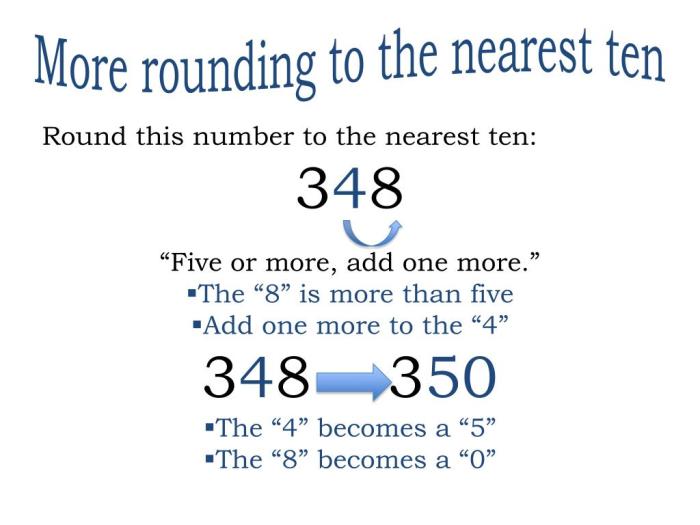Round 262 to the nearest ten – Rounding numbers is a fundamental mathematical operation that plays a crucial role in our daily lives. From estimating distances to calculating expenses, rounding helps us simplify complex calculations and make sense of the world around us. In this article, we’ll delve into the concept of rounding, with a particular focus on rounding 262 to the nearest ten.
We’ll explore the rules and techniques of rounding, providing clear examples and a step-by-step demonstration of the rounding process. Additionally, we’ll discuss the practical applications of rounding in various fields, highlighting its importance in estimation and approximation.
Understanding Rounding

Rounding numbers is a mathematical process of approximating a number to a specific level of accuracy, usually to the nearest whole number, tenth, hundredth, or thousandth.
Rounding is essential in mathematical operations to simplify calculations, make numbers more manageable, and enhance the clarity of results. It helps us estimate values, compare quantities, and make informed decisions based on numerical data.
Significance of Rounding in Mathematical Operations
- Simplification:Rounding can simplify complex calculations by reducing the number of digits to be processed, making it easier to perform operations and obtain approximate results.
- Accuracy Estimation:Rounding provides an estimate of the accuracy of a calculation. By rounding a result to a certain number of decimal places, we indicate the level of precision we have in the answer.
- Error Minimization:Rounding can minimize errors that may arise from using imprecise or estimated values in calculations. By rounding intermediate results, we reduce the accumulation of errors and obtain more reliable final answers.
Rounding to the Nearest Ten
Rounding to the nearest ten means approximating a number to the nearest multiple of ten. This is done by looking at the digit in the tens place and rounding up or down based on the value of the digit in the ones place.
Rounding Rules
- If the digit in the ones place is 5 or greater, round up.
- If the digit in the ones place is less than 5, round down.
Examples, Round 262 to the nearest ten
- Round 23 to the nearest ten: 23 is closer to 30 than 20, so we round up to 30.
- Round 78 to the nearest ten: 78 is closer to 80 than 70, so we round up to 80.
- Round 45 to the nearest ten: 45 is exactly halfway between 40 and 50, so we round up to 50.
Table of Rounding Examples
| Number | Rounded to the Nearest Ten |
|---|---|
| 17 | 20 |
| 35 | 40 |
| 62 | 60 |
| 89 | 90 |
| 105 | 110 |
Rounding 262 to the Nearest Ten

In this segment, we will explore the process of rounding the number 262 to the nearest ten. Rounding is a mathematical operation that involves approximating a number to a specified level of precision. When rounding to the nearest ten, we determine the closest multiple of ten to the given number.
Round 262 to the nearest ten is a challenging puzzle that requires careful consideration. If you’re looking for a fun and engaging way to test your crossword skills, check out the bad to the bone crossword . With its clever clues and witty wordplay, this crossword will provide hours of entertainment.
Once you’ve completed the crossword, come back to round 262 to the nearest ten for more puzzling fun.
Rounding Process
To round 262 to the nearest ten, we follow these steps:
- Identify the tens digit:The tens digit in 262 is 6.
- Check the unit digit:The unit digit is 2, which is less than 5.
- Round down:Since the unit digit is less than 5, we round down to the nearest ten. The nearest ten below 262 is 260.
Therefore, 262 rounded to the nearest ten is 260.
Applications of Rounding

Rounding is a fundamental mathematical operation that plays a crucial role in our daily lives, enabling us to estimate and approximate values with ease. Its practical applications extend across various fields, including science, engineering, finance, and even everyday decision-making.
Estimation and Approximation
Rounding is essential for estimation and approximation, allowing us to quickly obtain a close value without the need for precise calculations. For instance, when estimating the cost of groceries, we round up prices to the nearest dollar or ten cents to get a rough estimate of the total amount.
Measurement and Engineering
In measurement and engineering, rounding is used to represent values within a certain level of precision. For example, when measuring the length of an object using a ruler, we round the measurement to the nearest millimeter or centimeter to ensure accuracy within the limits of the instrument’s precision.
Financial Calculations
Rounding is widely used in financial calculations, such as budgeting, accounting, and investment analysis. When dealing with large sums of money, it is often impractical to work with exact values, so rounding is employed to simplify calculations and make them more manageable.
Scientific Calculations
In scientific calculations, rounding is used to handle large numbers or numbers with a high degree of precision. By rounding values to a manageable level, scientists can perform complex calculations more efficiently without compromising the accuracy of their results.
Common Misconceptions: Round 262 To The Nearest Ten

Rounding numbers is a fundamental skill in mathematics. However, several misconceptions can lead to errors in rounding. It’s essential to understand the correct rounding rules to avoid these mistakes.
One common misconception is that rounding always involves removing the digits after the rounding point. While this is generally true, there are exceptions. For example, when rounding to the nearest ten, a number ending in 5 is rounded up. This is because 5 is halfway between 0 and 10, so it is considered closer to 10.
Another misconception is that rounding is only used for approximating large numbers. While it’s true that rounding is often used to make large numbers more manageable, it can also be used for smaller numbers. For example, rounding can be used to estimate the cost of groceries or the distance to a destination.
Tips to Avoid Errors in Rounding
- Understand the rounding rules for the specific rounding point you are using.
- Pay attention to the number you are rounding. For example, when rounding to the nearest ten, look at the digit in the tens place.
- If the digit in the rounding place is 5 or greater, round up. If it is less than 5, round down.
- Double-check your answer to make sure it is correct.
FAQ Explained
What is rounding?
Rounding is the process of replacing a number with an approximate value that is easier to work with.
Why is rounding important?
Rounding helps us simplify calculations, estimate values, and make sense of large or complex numbers.
How do I round 262 to the nearest ten?
To round 262 to the nearest ten, we look at the digit in the tens place, which is 6. Since 6 is closer to 10 than to 0, we round 262 up to 270.
